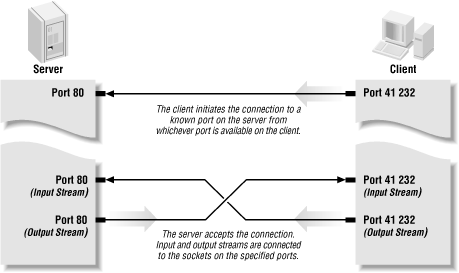The Client/Server Model
Most modern network programming is based on a client/server model. A client/server application typically stores large quantities of data on an expensive, high-powered server, while most of the program logic and the user interface is handled by client software running on relatively cheap personal computers. In most cases, a server primarily sends data, while a client primarily receives it, but it is rare for one program to send or receive exclusively. A more reliable distinction is that a client initiates a conversation, while a server waits for clients to start conversations with it. Figure 2.5 illustrates both possibilities. In some cases, the same program may be both a client and a server.

Figure 2-5. A client/server connection
Some servers process and analyze the data before sending the results to the client. Such servers are often referred to as “application servers” to distinguish them from the more common file servers and database servers. A file or database server will retrieve information and send it to a client, but it won’t process that information. In contrast, an application server might look at an order entry database and give the clients reports about monthly sales trends. An application server is not a server that serves files that happen to be applications.
You are already familiar with many examples of client/server systems. In 2000, the most ...
Get Java Network Programming, Second Edition now with the O’Reilly learning platform.
O’Reilly members experience books, live events, courses curated by job role, and more from O’Reilly and nearly 200 top publishers.

